| Brother Hibernian: H. RES. 596, introduced by Hibernian Brother Mike Lawler, calls for the restoration of power-sharing in Northern Ireland. It is a critical step in addressing the ongoing political stalemate and maintaining the progress to peace in the north of Ireland, started 25 years ago by the Good Friday Agreement. The devolved Stormont Assembly has been in collapse since February 3, 2022, denying the people of Northern Ireland their democratically elected voice in their local government. Unconscionably, the reason for this rift is an internal party dispute between the current British government and the Democratic Unionist Party (DUP) over the implementation of Brexit. The DUP supported Brexit, despite the broader Northern Irish Community rejecting it by 56% at the polls. Now, the DUP is cynically holding democracy in Northern Ireland hostage over ‘buyers regret’ on its implementation by their allies in Westminster. As members of the AOH, we have a deep and abiding commitment to the pursuit of justice, peace, and unity in the north of Ireland. The collapse of the Stormont Assembly and the resulting undermining of confidence in the peaceful institution of government and the Good Friday Agreement pose a significant threat to the progress made toward peace in Northern Ireland. We ask you to take less than 5 minutes to ask your Congressional Representative to cosponsor H. RES. 596 and reaffirm the U.S. commitment to peaceful governance in Northern Ireland. Please go to this link https://aoh.com/political-education-2/#/6, enter your contact details and it will bring up a template letter to you Congressional Representative, click send and you have made an important contribution to peace in the north of Ireland! I thank you in advance for your support. I also ask that you please share this call to action with your fellow Hibernians, friends, and relatives and ask them also to call. “Injustice anywhere is a treat to justice everywhere” and “the only thing necessary for the triumph of evil is for good men to do nothing.” Neil F. Cosgrove National Political Education Chair, AOH |
Phone Number for Florida Commerce Secretary Kelly (850) 245-7105
Please also consider calling your State Senator and State Representative
The script is provided below as an aid to this call to action; you can, of course, use your own words. If you use the script, please pre-read it so you are comfortable.
When you call, say, “I wish to speak to [ the person you are calling by title, for example, Governor DeSantis, Commerce Secretary Kelly]. You will likely be told that is not possible but that you can leave a message and then launch into the script or what you wish to say.
“Hello, my name is [YOUR NAME], a member of the Ancient Order of Hibernians from [YOUR TOWN/COUNTY IN FLORIDA]. I’m calling to voice my strong opposition to the proposed trade deal between Florida and the United Kingdom.
The news of a U.K. Florida trade deal following the recent passage of the Northern Ireland Troubles and Reconciliation Act by the UK Parliament deeply troubles me. The act denies justice to the victims of the conflict in Northern and grants amnesty for murder. It is opposed by all the communities of Northern Ireland, Catholics and Protestants, Loyalists, and Nationalists. Britain is imposing this legislation upon them without their consent. The UN, the Council Of Europe, and 90% of the people in Britain oppose this act. The only one supporting it is a British government trying to hide its past.
Considering Britain’s repeated failures to uphold international treaties regarding Northern Ireland, I believe it’s unwise for Florida to enter into a trade agreement with a partner that does not honor its previous commitments.
I urge you [NAME OF PERSON YOU ARE CALLING], to reconsider supporting this deal. It would not only betray the victims of the Troubles and their families but also send a message that Florida condones this amnesty for murder. As Dr. Martin Luther King Jr. once said, ‘Injustice anywhere is a threat to justice everywhere,’ injustice in the north of Ireland should not be rewarded with a trade deal by the state of Florida.
Thank you for your attention to this matter.”
]]>
The British Government has been anxious to sign a trade deal with the United States since BREXIT; the fact that the British Government has not been able to do so has embarrassed them.
Having been frustrated in getting an actual national trade deal, the British Government has embarked on a new marketing strategy: getting what it is marketing as “trade deals” with individual states. Now, these “trade deals” are more “memorandums of understanding” (Article I, Section 10 of the Constitution prohibits states from making independent trade deals). This is a cynical British marketing ploy. By getting a collection of supposed “trade deals” with individual states, the British are attempting to sell BREXIT at home while building momentum and a case for a real trade deal. They are aided by American politicians of both parties who see their own P.R. potential in announcing a “feel good” “trade deal” without realizing the consequences.
The U.K. recently concluded a “trade deal” with the State of Washington. U.K. trade minister Nusrat Ghani said, “Florida is next on the list. That should be concluded shortly.“
A win in Florida would give the U.K. tremendous momentum, but a loss would be seismic and deliver a clear message that injustice in Ireland has consequences. We are reaching out to all Florida Hibernians to contact their Governor to express their belief that callous injustice in Ireland should not be rewarded.
Neither the U.S. nor its states should reward the rejection of fundamental human rights in Ireland with a “trade deal.” We should not give something to Britain that we would withhold on human rights grounds if it were any other nation. Turning a blind eye to injustice is not the friendship of a “special relationship”; it is being an accessory in a crime.
]]>
With the passage today of the Northern Ireland Troubles (Legacy and Reconciliation) Bill, the government of Prime Minister Sunak has decided to add their own sad chapter in the history of Britain’s callous disregard for the rights of the Irish people. The bill trades equal access to the courts and justice that are the mark of all democratic societies for an unrealistic, forlorn hope that perpetrators of killings and torture will, after decades of literally getting away with murder, will now have a ‘Road to Damascus” moment.
In rare unanimity, the bill is opposed by all major Northern Ireland Political parties and all segments of the Northern Ireland community. The bill is as undemocratic as it is unjust; it reflects a return to Britain’s imperial attitudes of the 19th century, not the values of the world of the 21st.
In unilaterally adopting this bill, the United Kingdom has violated the Good Friday, Stormont House, and Fresh Start Agreements, which now join the dubious company of the Treaty of Limerick and the Third Home Rule Bill. It is yet another sad justification of Britain’s sobriquet “Perfidious Albion.” With this track record of broken commitments and promises, how can one have faith in the dubious truth recovery provisions of the Northern Ireland Troubles (Legacy and Reconciliation) Bill?
As the largest Irish American Organization in the United States, we are reminded of the words of Dr. Martin Luther King: “Injustice anywhere is a threat to justice everywhere.” We cannot condemn atrocities in Ukraine by Russian Paratroopers while British Paratroopers are given an amnesty. We can not fall victim to what former Irish Ambassador to the U.S. Séan Ó hUigín termed as Britain’s “Irish Anomaly”: something that would be taken very seriously in another context can be disregarded if it comes with an Irish label. The victims of the Ballymurphy Massacre are as entitled to justice as the victims of Bucha. It is often stated that the United States and the United Kingdom have a “Special Relationship”; per the U.S. Embassy to the U.K. website, “a bilateral cooperation reflects the common language, ideals, and democratic practices of the two nations.” In passing the Northern Ireland Troubles (Legacy and Reconciliation) Bill, the United Kingdom has violated those “ideals and democratic principles.” We shall ask our elected representatives to reexamine the “Special Relationship” in light of Britain breaking with the standards of justice that Americans and all modern societies hold dear.
]]>
In an unprecedented move, the President of America’s largest Irish American Organization, the Ancient Order of Hibernians (AOH), has written a letter to each member of the British House of Commons expressing strong opposition to the Northern Ireland Troubles (Legacy and Reconciliation) Bill currently before parliament. This marks the first time that the AOH, an influential Irish-American organization, has reached out directly to Members of Parliament, highlighting the significance of the issue. The text of the letter is as follows:
In every official meeting between the United States and the United Kingdom, there is invariably a mention of the “Special Relationship” between our two countries. The bedrock of that relationship is our shared history and values. I write to you as the Northern Ireland Troubles (Legacy and Reconciliation) Bill currently before parliament is a grave threat to that relationship.
The concept that no one is above the law, that all people are accountable for their actions and are entitled to justice, is one of the landmarks of Magna Carta and one of the great legacies that the British people have given the world. The Northern Ireland Troubles (Legacy and Reconciliation) Bill repudiates that noble legacy by creating a protected class and denying victims of criminal action justice solely based on the time and place where the crime occurred. It violates Article Two of the European Convention of Human Rights and the accepted standards of justice of all democratic nations.
The Northern Ireland Troubles (Legacy and Reconciliation) Bill has achieved the rare distinction of uniting the Northern Ireland community (who, ironically, proponents of this bill claim will be the “beneficiaries”) in unprecedented unanimity in opposition. The bill has been condemned by the United Nations, the Council of Europe, and in several letters and statements by members of the U.S. House and Senate. In a recent poll, 90% of U.K. citizens opposed the bill. This begs the question “Cui Bono?”
The main argument made by proponents of this bill is that “too much time has passed for effective prosecutions.’ We frankly find this argument fallacious. The passage of time has not been solely due to a natural course of events but largely a result of the prolonged delays in implementing commitments under the Good Friday, Stormont House, and Fresh Start Agreement Agreements. If the United Kingdom had acted on its obligations under those agreements, we believe significant progress could have been made in resolving the backlog of legacy now being used as a pretext for this bill.
Secondly, we note that just two weeks ago, Attorney General Dame Brenda King ordered a new inquest into the murders of five Catholic men in four separate attacks, citing “deficiencies” in the original investigations and “new information not considered at the first inquests.” If new information is still being developed in this and other cases, how can it be stated “too much time has passed for prosecutions?” I also draw your attention to 25 June this year when a British jury found John Apelgren guilty of killing 22-year-old sex worker Eileen Cotter on 1 June 1974. It defies logic that we are asked to accept that a murder in London in 1974 can be successfully prosecuted while the murder of a priest, shot in the back while administering the last rights to another victim in 1971, cannot.
Where the “too much time has passed argument” does have merit is showing that the proposed “truth recovery” process that the Northern Ireland Troubles (Legacy and Reconciliation) Bill would substitute for justice is a fantasy. Are we expected to believe that perpetrators who have successfully avoided prosecution for decades will now have pangs of conscience and line up to confess their misdeeds, refuting tales they have told their children and grandchildren about their role in the Northern Ireland Conflict?
The proposed bill threatens to undermine the delicate balance achieved through the Good Friday Agreement. Such a course of action has the potential to strain relationships, both within Northern Ireland and internationally, and jeopardize the progress that has been made towards a lasting peace. It threatens the “Special Relationship,” for at the heart of any relationship is trust; if a nation can not keep faith with its commitments under international treaty and with its moral obligation to justice, how can the U.S. realistically have the trust to engage in future agreements with the U.K.?
We ask you to reject the Northern Ireland Troubles (Legacy and Reconciliation) Bill and to protect Britain’s reputation as the ‘cradle of common law’; we ask the United Kingdom be faithful to the ideals of William Blackstone and William Garrow and not emulate the model of Augusto Pinochet.
The letter is signed Daniel J. O’Connell, President of the Ancient Order of Hibernians.
]]>
Northern Ireland Secretary Chris Heaton-Harris stated today that the U.K. Government plans to continue to pursue the Northern Ireland Troubles (Legacy and Reconciliation) Bill, restoring to the bill provisions that would provide an amnesty for murder and torture, halt current and future investigations, and deny victims access to the courts. This action contravenes Britain’s pledged commitments under the Good Friday Agreement and the norms of justice of civilized societies, including the basic principles of the Magna Carta, which holds that no one is above the law.
The Northern Ireland Troubles (Legacy and Reconciliation) Bill has achieved the rare distinction of unifying the major political parties in opposition, parties that currently can not agree to form a government. The Council of Europe’s Committee of Ministers, the Parliamentary Assembly of the Council of Europe, the U.N. High Commissioner for Human Rights, U.N. Special Rapporteurs, national human rights institutions, parliamentary committees, members of the U.S. House and Senate, and civil society organizations, including victims’ groups, have all denounced this bill. A recent poll reported that nine in 10 U.K. adults said perpetrators should still be prosecuted for serious crimes even if they were committed decades ago.
Only one group favors this legislation: those who wish to hide their misdeeds in the shadows of injustice, and that includes the British Government.
It is no coincidence that this legislation was announced in the Queen’s Speech on the very day a British Coroner’s court found that the ten civilians killed by members of the British Parachute Regiment were “completely innocent.” Nine days later, then Prime Minister Boris Johnson apologized “unreservedly on behalf of the U.K. government for the events that took place in Ballymurphy and the huge anguish that the lengthy pursuit of truth has caused the families of those killed .” Prime Minister Johnson concluded that “No apology can lessen [the victims’] lasting pain.’
Yet that is, at most, what the Northern Ireland Troubles (Legacy and Reconciliation) Bill would offer the victims of Ballymurphy and the families of hundreds of victims of violence perpetrated by Crown forces: an apology.
Even the possibility of families getting that modicum of relief is questionable as the bill is based on the wildly optimistic belief that those who have reached old age, having lived lives of stolen valor with medals on their chests and various honors after their names, will now have pangs of conscience and confess. Even Professor Pangloss and Pollyanna would be skeptical of the success of such a process.
The U.K. often seeks to leverage what it perceives to be a “Special Relationship” between the United Kingdom and the United States, a relationship built on “common language, ideals, and democratic practices.” Granting an amnesty for murder and denying victims access to the judicial system are not American ideals.
The Ancient Order of Hibernians calls upon all elected U.S. leaders to denounce the U.K.’s legacy bill; to remain silent is not the act of a friend but the actions of an accessory after the fact. If the Sunak government persists in this bill, the United States must reevaluate and reconsider “the special relationship.”
]]>
AOH Brother Congressman Brian Fitzpatrick will join victims’ relative Patsy Kelly, civil rights lawyer Niall Murphy, and justice campaigner Andree Murphy in a live webinar broadcast hosted by the Ancient Order of Hibernians (AOH) this Saturday, June 10th, at 10 AM Eastern Time, 3 PM Irish time.
By its appointment of former Chief Justice Declan Morgan to head its new legacy commission, the British government is clearly signaling its intention to move ahead with the Northern Ireland Troubles (Legacy and Reconciliation) Bill, despite overwhelming opposition by victims’ relatives, human rights campaigners, the Irish government and all major six county political parties. While British Prime Minister Rishi Sunak is visiting Washington DC, victims’ relatives are making an emergency appeal for American help as their best hope to stop a bill designed to cut off legal channels for justice.
The British amnesty bill aims to discard Britain’s Stormont House Agreement on legacy mechanisms with the Irish government and end criminal cases, Historical Investigations, Inquests, civil suits or Ombudsman investigations, which could give the truth in hundreds of cases, including British crown force or collusion killings. Instead, the British want to set up an Independent Commission for Reconciliation and Information Recovery (ICRIR), which victims’ relatives fear will bury the truth along with the victims. Although the amnesty bill has not yet been passed at Westminster, the British have already announced the appointment of retired Chief Judge Declan Morgan to head the Commission.
Panelists
- Republican Congressman Brian Fitzpatrick has been one of the leading Washington voices on Irish issues and a driving force on a series of Congressional initiatives, House Resolutions and Briefings on legacy justice. Most recently, he co-signed a strongly worded letter to British Secretary Chris Heaton Harris, expressing deep disappointment at the moves to push ahead with an amnesty bill despite the opposition of nationalist and unionist victims.
- Patsy Kelly Jr., is the son of Independent Councillor Patsy Kelly, who was abducted from work in County Tyrone and murdered in July 1974. The family has always believed the murder was carried out by members of the British Army’s Ulster Defense Regiment, and a recent Ombudsman Investigation ruled that there had been collusive behavior by the Royal Ulster Constabulary. Now the Kelly family’s 50-year fight for justice is threatened by the proposed British amnesty bill.
- Civil rights lawyer Niall Murphy will explain the legal implications of the amnesty law and how badly the law will affect families who have waited decades for truth and would be compelled to begin a long legal battle in the European Court of Human Rights.
- Andree Murphy, the Deputy Chair of Relatives for Justice, will discuss the importance of American help in the continuing political and legal battle for legacy justice.

As President Biden arrives in Ireland to mark the 25th anniversary of the Good Friday Agreement, we recognize the tremendous progress that has been made in Northern Ireland since its signing. The agreement has brought about an unprecedented era of peace and stability, and its positive impact on the people of Northern Ireland cannot be overstated.
However, we cannot let the significant achievements made over the past 25 years distract us from the significant challenges and threats the Good Friday Agreement and a lasting peace still faces. The ongoing political deadlock in Northern Ireland as the Democratic Unionist Party, the only party not to sign the Good Friday Agreement, fails to participate in government over its disagreement with how Westminster has implemented the Brexit the DUP campaigned for. Moves by the British government to enact an extraordinary amnesty for murders committed by its agents during the conflict in Northern Ireland seek to deny the justice that the Good Friday Agreement promises. There are continuing threats of violence from dissident groups. All this serves as reminders of the work that still needs to be done to fully implement the agreement.
Given these challenges, it is more important than ever for the United States to remain engaged in Northern Ireland. The U.S. played a vital role in brokering the Good Friday Agreement. Its continued support will be crucial in ensuring that the agreement remains a cornerstone of peace and stability in the region.
As we reflect on the 25th anniversary of the Good Friday Agreement, we must renew our commitment to the principles of peace, reconciliation, and respect for human rights that underpin the agreement. By doing so, we can build a brighter future for the people of Northern Ireland and ensure that the progress made over the past 25 years is not lost.
]]>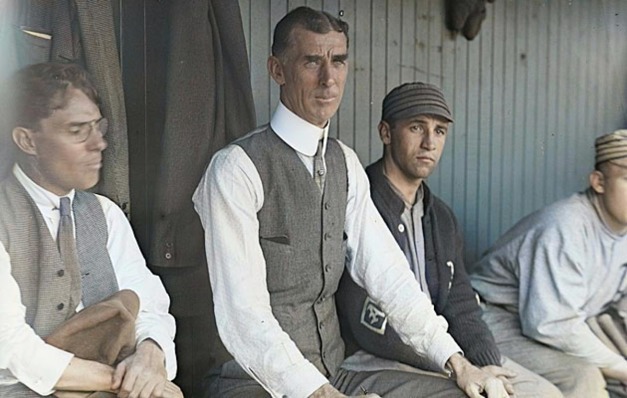
Baseball is a sport built for superlatives and appellations; with every passing season, another member of the sport seems to be bestowed the title of “the Greatest” or a nickname. Yet, there is only one “Grand Old Man of Baseball,” and there will never be another like Irish American Connie Mack nor anyone as deserving of the title.
Connie Mack was born Cornelius McGillicuddy in Brookfield, Massachusetts, on December 22, 1862. His parents were both Irish immigrants, Michael McGillicuddy from Killarney, while Mary (nee McKillop) McGillicuddy was from the Catholic section of Belfast. Connie would never legally change his name of McGillicuddy and used it on all formal documents but would use ‘Mack’ as his last name in all other situations.
Mack’s father was a Civil War Veteran whose health had been destroyed by his service. The family eked out a survival based on a meager disability pension supplemented when the father could work and could find it. Mack left school at age 14 to help support his family. It was remembered that he would always give his mother whatever he earned. Later in life, Mack would always be self-conscious about his lack of formal education.
One advantage of working in the local factories and mills was a lunch hour where Mack would play baseball, which he would follow up with additional playing in the evening when work and chores were done. Standing 6′ 2″, Connie Mack was already the tallest boy in town and quickly earned the name of “Slats” for his height and slim build. In 1879 he was playing for Brookfield’s town team. Only 17, Mack was much younger than his teammates but was the team’s catcher and de facto captain.

In 1886, Mack began a major league career (though the term’ major leagues’ was not coined yet) as a catcher. Sports writer Bill James described Mack’s playing career as “a light-hitting catcher with a reputation as a smart player but didn’t do anything particularly well.” That is both uncharitable and inaccurate. Mack was an expert at “the dark arts” of being a catcher. Instead of positioning himself in front of the backstop like other catchers, Mack was among the pioneers who positioned himself directly behind the home plate. According to a contemporary opponent Wilbert Robinson, “Mack never was mean … [but] if you had any soft spot, Connie would find it. He could do and say things that got more under your skin than the cuss words used by other catchers.” In addition to distracting hitters, Mack also honed skills such as blocking the plate and simulating the sound of a foul tip when the then rules stated that any pitch tipped and caught by the catcher was an out. Mack was also an expert at “tipping bats” (catcher’s interference) to throw off a hitter’s swing.
Mack’s final three seasons were with the Pittsburgh Pirates from 1894 to 1896, where he served as a player/manager and compiled a 149–134 (.527) record. In 1896, he retired as a full-time player to begin the career he became famous for as a manager. After a four-year stint as a manager for the then minor league Milwaukee Brewers, Mack became manager, treasurer, and part-owner of the new American League’s Philadelphia Athletics. Mack guided the A’s to triumph, leading them to capture nine pennants and reach eight World Series, ultimately securing five victories..
Mack revolutionized the position of baseball manager. He was praised for his intelligent and innovative management, which earned him the nickname “the Tall Tactician.” He was among the first managers to strategically reposition his fielders during the game, frequently guiding outfielders by waving his rolled-up scorecard from the dugout.. He valued intelligence and “baseball smarts,” trading away Shoeless Joe Jackson despite his proven worth as a hitter because of his poor attitude and unintelligent play. Mack’s strength was finding the best players, teaching them well, and letting them play. In an age when baseball was known for its flamboyant rowdy individuals, Mack developed the need for what we would now call ‘team culture.’ The Times wrote of Mack, “He was a new type of manager,” The Times observed. “The old-time leaders ruled by force, often thrashing players who disobeyed orders on the field or broke club rules off the field. One of the kindest and most soft-spoken of men, he always insisted that he could get better results by kindness. He never humiliated a player by public criticism. No one ever heard him scold a man in the most trying times of his many pennant fights.”
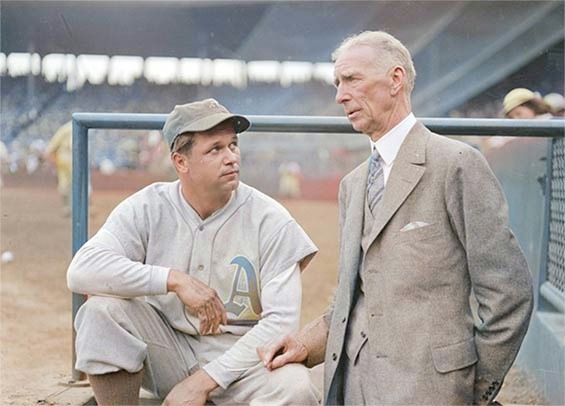
However, what set Connie Mack apart was that he was known as a consummate gentleman, a trait he attributed to his Irish mother. Going against the baseball manager stereotype, he rarely drank and didn’t smoke or curse. Time magazine once said, “Mr. Mack, as his players called him, remained a gentleman. Rumor had it that the harshest expletive was a mild ‘goodness gracious.‘” Ironically, Connie Mack did have a temper, which is why he adopted the practice of wearing his signature business suits rather than the team uniform, as was the habit of other managers. This meant that he did not need to go to the locker room with his players after a game to change, and by the time the team cooled emerged, he would have cooled down.
Mack also had a wry sense of humor. When fellow manager John McGraw described the A’s as a “white elephant that would never make money,” Mack had a picture of an elephant added to the uniform, turning the insult into a badge of pride. The use of the white elephant logo is still used by today’s Oakland A’s continues.
However, when McGraw was proved at least partially correct, the team struggled financially, resulting in Mack having to sell off players to keep the team viable, earning him an unjust reputation as ‘miserly.’ On the contrary, Mack supported a large extended family and demonstrated kindness to players who were down on their luck, including paying for one former player’s funeral. More than once, a fellow Irish American would claim to be a relative; Mack knew they weren’t while at the same time leaving some free tickets for them at the box office.
Connie Mack would manage the Athletics for fifty years, compiling a record of 3,582–3,814 (.484) when he retired at 87.When Mack retired as a manager at 87, old age and the changing nature of the game had caught up with him, and it can be argued that he diluted his Baseball accomplishments by hanging on too long. Still, nothing can diminish his influence on the game of baseball or the qualities as a gentleman instilled in him growing up in an Irish American household.
]]>“Humanity is the keystone that holds nations and men together,” Mack once said. “When that collapses, the whole structure crumbles. This is as true of baseball teams as any other pursuit in life.“
Connie Mack

At the 11th hour of the 11th day of the 11th month of 1918, for the first time in over four years, the guns fell silent across the trenches that scarred the face of Europe during the First World War. America had been latecomers to the conflict but at a tremendous cost had tipped the scales in what had been a murderous stalemate. No division had sacrificed more than the 42nd Division, nicknamed the “Rainbow Division,” as it had been formed from National Guard Units whose origins stretched across the country. No unit in the Rainbow Division fought on more fronts, nor suffered more casualties, than the regiment that represented the green in that rainbow: the 165th, the federal number assigned to the 69th New York. It was the same New York 69th that fifty years earlier, as a unit of the Irish Brigade, had been given the nickname of “the fighting 69th” as a tribute of respect by an enemy commander, Robert E. Lee. While the regimental number had changed, the unit and the New York Irish would once again prove worthy of that title, and no one was more responsible for the regiments unequaled record in WW I than Col. William “Wild Bill” Donovan.
Even before the war, William Joseph Donovan was a hero of Horatio Alger proportions. The grandson of immigrants from Skibbereen, Co Cork, he had literally been born on the wrong side of the tracks in Buffalo, New York. Yet, as typical of Irish immigrants, each generation was climbing the American dream’s long ladder. While Donovan’s grandfather had worked shoveling grain in the holds of ships, his father had risen to the influential position of yardmaster for the local railroad. Young William Donovan continued the trend, attending Columbia University, where he would earn a law degree. Donovan was a star quarterback of the Columbia football team in an age where amateur athletes were treated like today’s professional superstars. It was here he earned the nickname “Wild Bill Donovan.” He returned to Buffalo, started a law practice, and married the daughter of the wealthiest man in Buffalo.
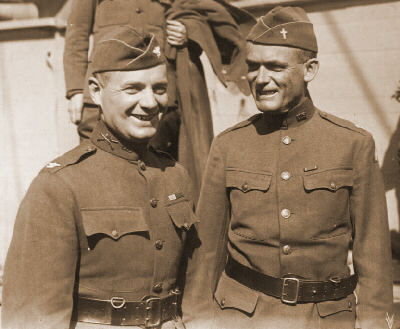
Yet, Donovan was not a man to rest on his success; his strong sense of duty and patriotism called him to seek an opportunity to serve his country. With several friends, Donovan formed a National Guard company of cavalry that served when the Army was mobilized to hunt for Pancho Villa. When the United States entered World War I, Donovan was called back to service and assigned as a Major to the 165th regiment, the number given to the rechristened N.Y. 69th which had won glory in the American Civil War as part of the “Irish Brigade”. He was a popular choice with the mostly Irish American regiment, particularly their Chaplin, Fr. Francis Duffy , who himself would win fame and honor with the regiment. Donovan applied the same tough discipline to his men’s training as he had experienced himself as an athlete on the playing field of Columbia, training his men would come to appreciate on the battlefields of France.
In France, at the river Ourcq, nicknamed by the Irish of the 165th “the O’Rourke,” the 42nd Division was ordered to cross the river and secure a ridge and farm on the other side. The position was believed to be “lightly held” when in fact they were being faced by three German Divisions, including one of elite Prussian Guards. Only Donovan’s 165th managed to reach its objective, the units on the left and right having been pushed back. The result was the 165th was cut off and subjected to machine gun and artillery fire on three sides. It was estimated that the Germans had one machine gun for four of Donovan’s men. Donovan and his men held their position for three days until the rest of the Division could reinforce the 165th but at a terrible cost: of the 3,000 men who entered the battle, 1,750 men and 66 officers were lost. Donovan himself was exposed to poison gas and wounded, yet still continued to lead his men. In one case, Donovan, without regard to danger, crossed open ground under heavy enemy fire to communicate coordinates for support artillery. For this action, Donovan was awarded the Distinguished Service Cross and promoted Lt. Colonel.
Tragically, these circumstances repeated themselves only a few months later when the 165th was again asked to breach a line of German fortifications. Again, the 165th was going up against some of Germany’s best troops, not with the battle-hardened men they had lost at the Ourcq, but young and inexperienced replacements. Describing it as “foolish but necessary” to his wife in a letter written before the battle, Donovan put on his full regulation uniform and insignia. He knew that he would be a target for German snipers by so obviously identifying himself as a senior officer, but he also knew that his raw men needed to see him out in front. During the German attack, Donovan was severely wounded but continued to encourage his men and refused all attempts to evacuate him till the battle was over. For his actions, Donovan was awarded the Medal of Honor and became the most decorated soldier of WW I.
“They’re not going to see your faces, but they will never forget what you looked like.”
William Donovan

On arriving back in New York, Donovan and his men were honored with a parade down 5th Avenue and, appropriate for the men of the 69th/165th, past St. Patrick’s Cathedral. Donovan ordered his men to march wearing their steel helmets, ammunition boots with their weapons, rather than dress uniforms, saying, “They’re not going to see your faces, but they will never forget what you looked like.” Donovan himself elected to march with his men rather than ride the traditional horse. The regiment marched to the strains of the regimental march “Garryowen” to City Hall, where they were presented with “the freedom of the City.” Later that night in camp, Donovan heard some of his men singing “The Good Old Summer Time,” a tune which many of his men now buried in France, sang as they went up to the line for their first battle. Donovan wept.
Despite having already accomplished enough to fill multiple lifetimes, history was still not done with “Wild Bill” Donovan. He would become a successful lawyer, federal prosecutor, and a confidant to Presidents for his clear and pragmatic thinking. In the inter-war years, Donovan was often used as a presidential agent, especially when it came to foreign intelligence matters. In World War II, Donovan created the Office of Strategic Services, the O.S.S., the precursor to today’s C.I.A., and attained the rank of Major General. After the war, he would assist in prosecuting Nazi war criminals at Nuremberg.
Little wonder that when informed that William Donovan had died peacefully after a life of honor and service to his country, then-President Eisenhower remarked, “What a man! We have lost the last hero.”
THIS IRISH AMERICAN HERITAGE MONTH PROFILE IS PRESENTED BY THE ANCIENT ORDER OF HIBERNIANS (AOH.COM)
#IrishAmericanHeritageMonth
Neil F. Cosgrove ©
Philip Fitzpatrick was born in Aughavas, Co. Leitrim in 1892. Like so many of his generation, he emigrated to the United States and settled in New York City. He joined the NYPD in 1926 and was assigned to Mounted Squad 1 in Manhattan. He would serve with distinction for over 21 years as one of ‘New York’s Finest’ and would prove more than worthy of the title.
However, in addition to protecting the streets of New York, Patrolman Fitzpatrick had another talent that few realized until many years after his death; he was a talented poet. Fitzpatrick came from a family having a long musical tradition going back through the generations. His best-known poem was a tribute to the County of his birth, “Lovely Leitrim,”; the story of an immigrant dreaming of returning to his homeland and seeing once again the sights he once knew and now cherishes in his heart. In another moving poem he wrote about his experience as a father saying goodbye to his son Charles as he leaves to join the Marines in WW II.
Fitzpatrick also wrote a poem to honor his fellow police officers, whom he described as “Soldiers of Peace.” In the poem, he describes the fear well known to all police families that when he “kisses his wife and children goodbye, there’s a chance he will see them no more.” Sadly, for Officer Phillip Fitzpatrick, the line was prophetic.
On Tuesday, May 20, 1947, Patrolman Fitzpatrick was off duty and having lunch with his friend Patrolman George H. Dammeyer at a tavern located at 1703 Third Avenue and East 96th Street on the Upper East Side of Manhattan. While they were dining, two career criminals armed with pistols entered the tavern after having just robbed another location nearby, where they pistol-whipped their victims. The criminals proceeded to demand money and valuables from everyone in the tavern, pointing their pistols at both the customers and staff.
Despite the great risk to their own safety, Patrolman Fitzpatrick and Patrolman Dammeyer bravely attempted to apprehend the criminals. During the altercation, Fitzpatrick was shot twice in the stomach and suffered grievous wounds while struggling with one of the perpetrators. However, Patrolman Dammeyer managed to shoot and kill both of the criminals.
Phillip Fitzpatrick succumbed to his wounds and passed away on May 26, 1947, leaving behind his wife Mary and five sons. In recognition of his bravery and sacrifice, Patrolman Fitzpatrick was given an Inspector’s funeral and was posthumously awarded the NYPD Medal of Honor. His son Charles, whose leaving for the Marines he had memorialized, was now himself a police officer and was given his father’s Shield, No. 15348. Phillip Fitzpatrick had never made it back to his home County of Leitrim except in his dreams and poetry. He was remembered as a proud Irishman and a devout Catholic who was a member of the Holy Name Society and a committed member of the Ancient Order of Hibernians.
It would not be until twenty years after his death that Phillip Fitzpatrick’s poem “Lovely Leitrim” gained notoriety by singer Larry Cunningham. Despite admiring the song, Cunningham released it as a ‘B-Side’ because he knew that RTÉ (Ireland’s dominant radio station) would never play it. While Cunningham was correct, the hand of radio producers was forced when the song was frequently requested. “Lovely Leitrim” would go on to be a number-one record, displacing the Beatles’ “Day Tripper,” selling over a million copies. The song has become an unofficial anthem for County Leitrim.
Sadly, many do not know that behind the ballad “Lovely Leitrim” stands a heroic son of Leitrim who is memorialized on the walls of NYPD headquarters at One Police Plaza.
To his County and the People of New York, he was ‘faithful unto death”, the motto of the NYPD.
]]> John Joseph Hughes was born on 24 June 1797 in Annaloghan, Co. Tyrone, to a poor farmer. As a Catholic in English-ruled Ireland, he couldn’t even receive a Catholic education. When John was 15, his younger sister, Mary, died and British law barred a Catholic priest from presiding at her burial; the best he could do was to scoop up a handful of dirt, bless it, and hand it to John to sprinkle on her grave. Hughes never forgot that and dreamed of ‘a country in which no stigma of inferiority would be impressed on my brow, simply because I professed one creed or another.’ Fleeing poverty and persecution, John’s father brought the family to America in 1817 and settled in Chambersburg, PA. John made unsuccessful applications to study at Mount St. Mary’s College in Emmitsburg, MD, but was hired by its rector as a gardener. Working there rekindled his childhood dream of becoming a priest; he asked again if he could enroll as a student and was turned down because of his lack of education. John befriended Mother Elizabeth Ann Seton who persuaded the college to reconsider and Hughes was admitted in September 1820.
John Joseph Hughes was born on 24 June 1797 in Annaloghan, Co. Tyrone, to a poor farmer. As a Catholic in English-ruled Ireland, he couldn’t even receive a Catholic education. When John was 15, his younger sister, Mary, died and British law barred a Catholic priest from presiding at her burial; the best he could do was to scoop up a handful of dirt, bless it, and hand it to John to sprinkle on her grave. Hughes never forgot that and dreamed of ‘a country in which no stigma of inferiority would be impressed on my brow, simply because I professed one creed or another.’ Fleeing poverty and persecution, John’s father brought the family to America in 1817 and settled in Chambersburg, PA. John made unsuccessful applications to study at Mount St. Mary’s College in Emmitsburg, MD, but was hired by its rector as a gardener. Working there rekindled his childhood dream of becoming a priest; he asked again if he could enroll as a student and was turned down because of his lack of education. John befriended Mother Elizabeth Ann Seton who persuaded the college to reconsider and Hughes was admitted in September 1820.
After graduation, he served the diocese of Philadelphia as a seminarian until 5 October 1826 when he was ordained a priest by Bishop Henry Conwell. During his early years as a priest, Hughes founded St. John’s Orphan Asylum in 1829 and in 1832 was responsible for building the new church of St. John the Evangelist – one of the most impressive churches in the country at that time. His initiative was recognized and on 7 August 1837, Pope Gregory XVI made 40-year old Hughes coadjutor Bishop for the Diocese of New York, which then included all of New York State and northern New Jersey. He was consecrated in old St. Patrick’s Cathedral on 7 January 1838. Between 1820 and 1830, immigration had swelled the U.S. Catholic population to 600,000 with no end in sight. The new immigrants were mostly Irish: impoverished, uneducated and unskilled, with little to prepare them for New York’s urban environs. Hughes believed that the barrage of Nativist anti-Catholic prejudice at the time was demoralizing the already disadvantaged immigrants and holding back their progress.
Recalling his own difficulties with a lack of education, he believed that the future of the Irish in America depended on secular education. At the time, the city’s schools were run by the Public School Society which received state funding. However, that society was a private Protestant group that taught that ‘emigration from Ireland of annually increasing numbers, extremely needy, and in many cases drunken and depraved, has become a subject for all our grave and fearful reflection.’ To get his flock educated, Hughes wanted an end to biased sectarian education. He contacted representative of New York’s Jewish community and allied with them to end all religious teaching in schools and through their efforts, the Maclay Bill of 1842 was enacted to bar all religious instruction from schools receiving state funds. On the night the bill was passed, a nativist mob attacked Hughes’s residence and members of the AOH were called to protect the city’s Catholic churches as they had done in 1841 and would do again in 1844.
Having reformed the public schools to help those non-protestant children who attended them, Hughes threw his energies into building a Catholic school system. ‘We have to build the schools first and the church after’ he said. In 1838 he felt that 100 acres bordering the Bronx River was the perfect spot for a new seminary and college and three years later, St. John’s College, the first Catholic institution of higher learning in the northeast, was established. On 10 April 1846, the State of New York granted the College a university charter and in 1907, after adding a law school and medical school, the name was changed to Fordham University.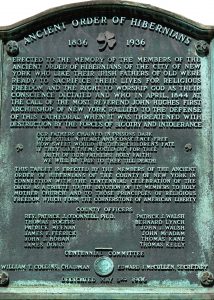
In 1844, James Harper, was elected Mayor of New York supported by the anti-immigrant American Republican Party consisting mainly of Nativists. A highly organized group of anti-Catholic Protestant fundamentalists, they saw the Catholic Church as incompatible with democracy and believed the United States should be a land for Anglo-Saxon Protestants only. At the time, nativist riots in Philadelphia claimed the lives of 30 Irishmen and burned Catholic churches and convents. Bishop Hughes defending the rights of Irish Catholics against such bigotry and bloodshed, sent a letter to Mayor Harper warning that if any harm came to a single Catholic church, he would turn New York into another Moscow, referring to the burning of Moscow during Napoleon’s invasion in 1812. He then called on the AOH to defend the Cathedral. As a massive Nativist torchlight parade gathered in City Hall Park, ready to march up the Bowery to the Cathedral, he stationed the Hibernians on the protective walls around the Cathedral. The Nativists backed down and Hughes’ powerful message and forceful actions are credited with averting the same anti-Catholic violence in New York that had plagued Philadelphia. Hughes won the nickname of “Dagger John,” not only for the cross he penned beside his signature but also for being a man not to be trifled with!
In 1850, New York was elevated to the status of an Archdiocese by Pope Pius IX, so, too, was Hughes’ own status elevated to that of Archbishop. He continued a vigorous mission of building churches, schools, and hospitals. Future American President James Buchanan called him, ‘one of the ablest and most accomplished and energetic men I had ever known. In a far-seeing move that many ridiculed at the time as Hughes’ Folly, the Archbishop proposed the construction of a new Cathedral in an undeveloped area far uptown on Fifth Avenue between 50th and 51st streets. The property was purchased in 1810 for the sum of $11,000. Archbishop Hughes laid the cornerstone for the new Saint Patrick’s Cathedral on 15 August 1858.
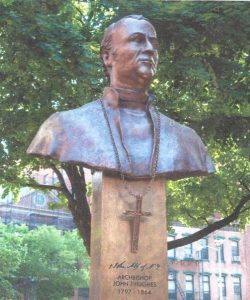
During the Civil War, Archbishop Hughes served as an envoy for President Lincoln on a successful overseas mission to dissuade European countries from supporting the Confederacy and in securing several officers of former Papal Army for the Union Army. In gratitude, Lincoln petitioned Pope Pius IX to name Archbishop Hughes as America’s first Cardinal. But the death took this indomitable leader in January 1864 before that honor could come to pass. His memory was honored by tributes from President Lincoln and other statesmen and his body viewed by over 200,000 people who solemnly came to worship in the old Cathedral where he was entombed in the crypts below. His body remained there until the new Cathedral was completed uptown and his remains were then removed to a crypt there in 1883. The new Cathedral holds the remains of all of the archbishops and cardinals that have served the Archdiocese since the death of Archbishop Hughes.
A statue of Archbishop Hughes stands on Fordham campus and a bust on a pedestal was erected by AOH Div 9 NY and the Friendly Sons of St Patrick at the old Cathedral with 3 bronze plaques on the fence.
Mike McCormack, National Historian
THIS IRISH AMERICAN HERITAGE MONTH PROFILE IS PRESENTED BY THE ANCIENT ORDER OF HIBERNIANS (AOH.COM)
#IrishAmericanHeritageMonth #EmbraceYourIrishHeritageAOH
]]>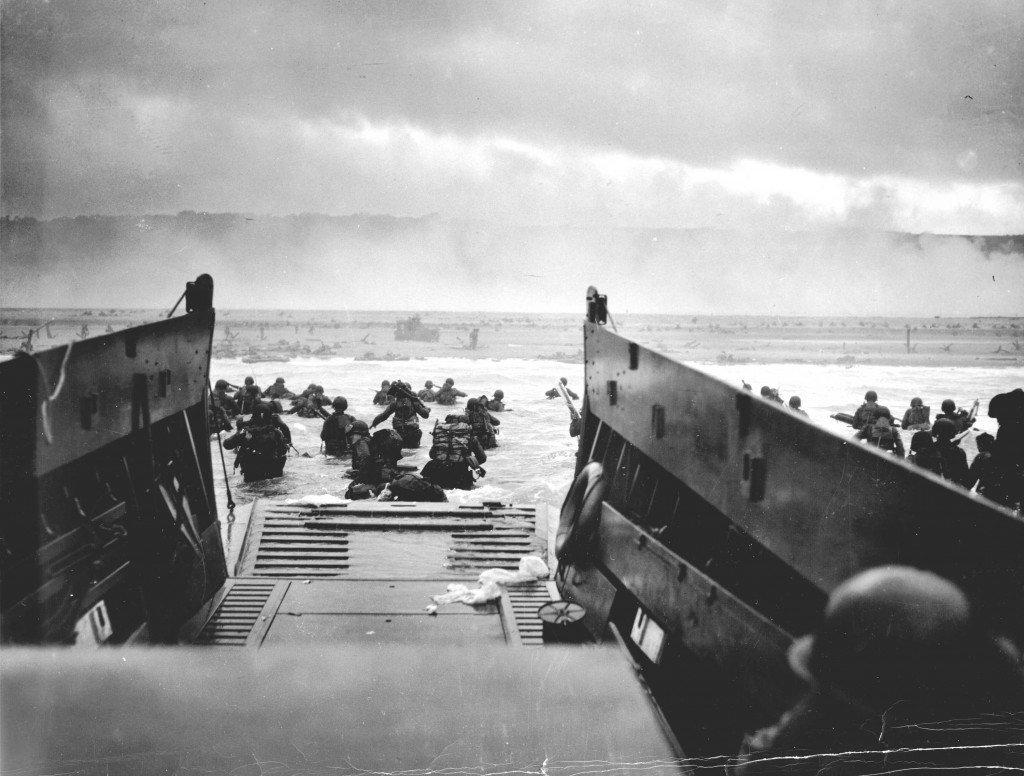
It is an iconic image of WW II, a photo taken on June 6, 1944 showing American soldiers exiting a landing craft coming ashore at Omaha beach. A few months later on October 20th, another photo captured the moment General Douglas MacArthur “returned” to the Philippines, wading ashore from a landing craft. Neither of these historic moments would have been possible without one man, as overlooked but essential as the landing craft in these images that bore his name, Andrew Higgins.
Though in later life Higgins would be inseparably identified with New Orleans, he was born in Columbus, Nebraska in 1886. Losing his father when he was but seven years old, Higgins would claim he received his determination and strong will from his mother whose ancestors had come from Ireland after the failed rebellion of 1848. Higgins demonstrated the industry and innovation that were to be his hallmarks at an early age. At the age of nine and with only a sickle he began a grass cutting business. He soon purchased a lawn mower, eventually expanding until he had seventeen mowers and was hiring older boys to do the work while he managed the business. An incurable builder, the young Higgins constructed an iceboat in the basement of his home for use on the nearby lakes. When finished, he realized it was too big to be taken out of the basement doors. With characteristic determination, he borrowed jacks from a nearby construction site and with friends removed a section of the basement’s wall, got the boat out and restored the wall, all while his mother was out shopping. Perhaps not unexpectedly, such creativity, determination and strong will often brought young Higgins into conflict with school authorities resulting in him being expelled before graduating.
Higgins moved to the south where he began working in the lumber industry. His interest in boats was again rekindled when he was confronted with the problem of how to access timber from shallow, obstacle choked bayous. Higgins took a correspondence course in naval architecture and soon designed the first of the flat-bottomed shallow draft boats which would make him famous. The key feature was that the propeller was incorporated in a recessed tunnel that protected the propeller from grounding and fouling.
In the late 1930’s Higgins owned a small shipyard in New Orleans servicing the need of loggers and oil drillers in the Mississippi Delta. The
growing threat of war soon drew the interest of the Marines in Higgins’ boats as the Navy Bureau of Ships had consistently failed to produce craft that could effectively deliver Marines, their tanks and artillery on a beach. Marine General Holland “Howlin’ Mad” Smith on seeing trials of Higgins shallow draft “Eureka” boat thought it could be “an answer to the Marine prayer”. The one concern was that as configured the Marines would need to disembark the boat going over the side, slowing their exit when they were most vulnerable. At his own expense, Higgin’s modified the boats by cutting off the bow and replacing it with a ramp. Higgins received a call from the Navy that they and the Marines would be coming to New Orleans to test the ramped boats and Higgins should also prepare to discuss a design for a craft capable of landing tanks. Higgins informed the Navy that instead of a plan he would have a workable craft. “It can’t be done,” the Navy told him; “The Hell it can’t,” replied Higgins, “you just be here in three days”. Higgins had the boat built in 61 hours. Both would be taken into service, and while the ramped “Eureka” would have the official designation of LCVP (Landing Craft, Vehicle, Personnel) it would be known universally as the Higgins Boat.
Higgins’ answer to the “Marine prayer” came just in time, as the United States would soon enter WW II. With his tireless energy, often working 16 hour days, Higgins seemingly overnight turned his small 50 man New Orleans boat building business into one of the largest boat builders in the world, building not only several models of landing craft but other boats as well. By September 1943, 12,964 of the American Navy’s 14,072 vessels had been designed by Higgins Industries. Hitler bitterly called Higgins “The new Noah”.
A fact that should not be overlooked is that to achieve this prodigious output Higgins employed anyone capable of performing the job, irrespective of gender or race, and everyone who performed the same job was given the same pay. Higgins was one of our nation’s first equal opportunity employers. Realizing the impact a worker lost due to sickness could have on productivity, Higgins established a company clinic where works could access health care free of charge.
Unfortunately, wartime gratitude is a fleeting thing. When the war ended, the drive and determination which had enabled Higgins to deliver what his country needed came back to haunt him as the toes he stepped on to get the job done now took their revenge. Maverick innovators like Higgins were out of place in the conformist world of post-war corporate America. Despite an indisputable record of being an advocate for his workers, his firms were crippled by post-war strikes. Higgins died in New Orleans on 1 August 1952.
Andrew Jackson Higgins was like the boat that bore his name: straightforward, tough and reliable. Neither was sophisticated, they just got the job done. He deserves to be remembered much more than he is. As General Eisenhower noted, “Andrew Higgins … is the man who won the war for us. … If Higgins had not designed and built those LCVPs, we never could have landed over an open beach. The whole strategy of the war would have been different.”
Neil F. Cosgrove ©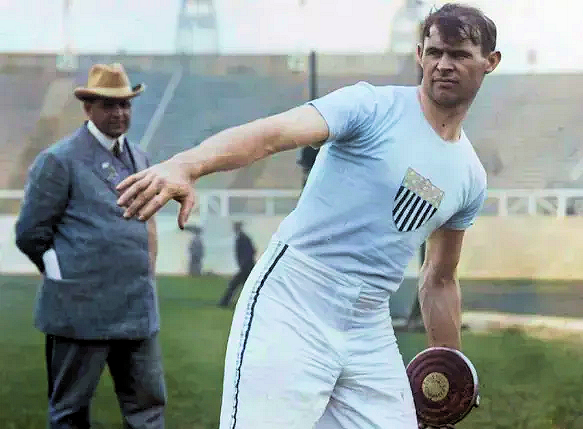
In his obituary, the New York Times describes Martin Sheridan as “one of the greatest athletes the United States has ever known.” While his name may not be as readily recognized today, that assessment still holds true. Sheridan was born in Bohola, County Mayo, Ireland in 1881, and would later emigrate to the United States. A giant for his time standing at 6′ 3″, he was a member of a group known as the “Irish Whales,” a group of Irish American Athletes who were also members of the New York City Police Department who dominated the track and field competitions of the early twentieth century.
He won his first gold medal at the St. Louis Olympics in 1904 in the discus, an event he was to dominate during his career. In the 1906 Olympics he would again easily win the discuss gold, but also a gold medal in shot putt, and silver in the standing long jump, the standing high jump and stone-throwing. He was the odds on favorite to win the pentathlon before having to withdraw due to a leg injury.
Sheridan is perhaps best remembered for an incident in the 1908 London Games. The games were mired in controversy from the start. It was the first games to have an “Opening Ceremony” and the now traditional parade of nations marching into the stadiums. Before the opening ceremony, it was noticed by the American team that while the stadium was surrounded with the flags of various nations (including the flags of China and Japan who were not competing), the British hosts had omitted the flag of the United States, claiming “they couldn’t find one.” Some Irish Athletes had already withdrawn when told they would be required to march behind the British flag.
The British organizers had issued a “protocol document” that instructed each team to dip their Country’s flag in homage as they passed King Edward VII in the royal box. When the U.S. contingent marched past, Color Bearer Ralph Rose refused to dip the American flag (allegedly after another Irish American competitor and NYPD officer Mathew McGrath had told Rose along the parade route “Dip that flag and you will be in a hospital tonight”.) . When questioned by British organizers, Martin Sheridan, the team captain, reportedly responded, pointing to the American Flag, “That flag dips before no earthly king.” While revisionists have questioned if Sheridan uttered those exact words, it is recorded that British officials did confront Rose, and the team, lead by Sheridan, quickly made clear that they supported his actions.
While retiring from Olympic competition, Martin Sheridan would continue a distinguished career to with the NYPD until his death one day before his 37th Birthday in 1918; Sheridan was one of the first victims of the infamous 1918 Flu epidemic.
The Unjust Downgrading of Sheridan’s 1906 Medals
Unfortunately. Martin Sheridan and other competitors of the 1906 Olympics, including Ireland’s Gold Medalist Peter O’Connor, have been cheated of their due recognition by the International Olympic Committee (IOC) when they decided to retroactively downgrade the 1906 Olympics and not recognize the medals awarded at that competition. In the infancy of the Olympic movement, the process of holding an Olympics was still evolving. After the 1900 and 1904 games had not successfully built upon the success of the initial 1896 Olympics in Athens; it was proposed to hold the Olympic games every two years, alternating between Athens, as the birthplace of the Olympics, and an international site. The 1906 Games were promoted as an Olympics by the IOC, had better participation than the two previous Olympics, and gave rise to many of the Olympic Traditions that are still practiced today (formal opening and closing ceremonies, the idea of athletes being members of a national team, an Olympic village where the athletes from around the world stay and socialize, the raising of the flags during medal presentations).
There may have initially been some cold, if unjust, logic in demoting the 1906 Olympic games and its medals given at the time its one-off nature, but since then the Olympics has engaged in many similar “one-offs”; most notably the current 2021 games, which are now five years from the last Olympics and only three years from the next. There is simply no reason, other than arbitrary obstinacy, for the IOC not to recognize Martin Sheridan and the other competitors of the 1906 Olympic Games medals as Olympic medals.
Please consider signing the petition below to the U.S. Olympic Committee and the International Olympic Committee calling for the medals of the 1906 Olympics to be recognized as Olympic medals.
]]>
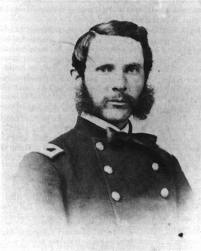
Patrick Henry O’Rorke was born in County Cavan, Ireland on March 25, 1837. His family emigrated from Ireland when Patrick was but a year old, eventually settling in the “Little Dublin” neighborhood of Rochester, N.Y. An excellent student, he earned one of two scholarships to the newly formed University of Rochester. However, his father’s sudden death required young Patrick to take a job as a marble cutter to support his family.
Patrick’s talents were too considerable to go unrecognized for long. He came to the attention of Congressman John Williams, who recommended him for the U.S. Military Academy at West Point. He was appointed to the Academy on January 20, 1857 and became the first Irish Immigrant to be enrolled in the Corps of Cadets. Despite the humbleness of his origins, foreign birth, Catholic religion and being a bit older than his fellow cadets, O’Rorke was well liked and respected by his classmates who knew him as “Paddy.” An upperclassman later recalled O’Rorke as “popular with all . . . I was impressed by his manly bearing – his kindness and unassuming manner.”
While O’Rorke was a member of the class of 1862, the outbreak of the war in 1861 and the shortage of trained officers resulted in his class’ studies being accelerated
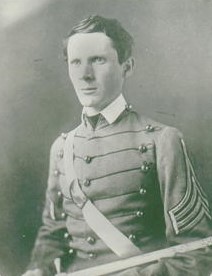
so that they would graduate with the class of 1861. Despite having to cram the final years’ worth of studies into six weeks, O’Rorke, the first Irish immigrant to graduate West Point, finished first in his class. As an aside, his better-known classmate George Armstrong Custer finished last. O’Rorke was appointed to the prestigious Corps of Engineers.
O’Rorke was at the First Battle of Bull Run where the new lieutenant had his horse shot out from under him. He then was assigned as an engineer to help prepare the defenses of Washington D.C. from what was feared would be an imminent Confederate assault. Later, he served with such conspicuous distinction during the siege of Fort Pulaski on Cockspur Island near Savannah, Georgia that O’Rorke was given the high honor of being one of the officers to receive the Confederate surrender of the fort.
O’Rorke returned to Rochester to be married to Clara Bishop and appointed Colonel of the newly formed 140th NY Regiment. The 140th New York was composed primarily of German and Irish recruits, half of the regiment’s soldiers were born in another country. Despite being only 25 and commanding a regiment of hardscrabble Erie Canal boatman and farmers, O’Rorke soon had them molded into an efficient military unit. O’Rorke’s adjutant Ira Clark wrote that “every man knew that in his Colonel, so long as he did his duty, he had a kind friend.”
O’Rorke and the 140th NY saw action at the Battle of Fredericksburg and Chancellorsville. On July 2nd, 1863 the 140th arrived by forced march at Gettysburg on the battle’s second day. As part of the 3rd Brigade, the 140th was immediately ordered to an area known as “the Wheatfield” to avert a potential disaster caused by a blunder made by Union General Dan Sickles. As the 3rd Brigade moved off with the 140 the last regiment in line, General Gouverneur K. Warren rode up to O’Rorke. Warren had discovered that a steep hill called “Little Roundtop” which dominated the Union position had been left undefended. Warren knew O’Rorke from West Point, he had been his Mathematics instructor. He ordered O’Rorke to reinforce Little Round Top; “Never mind (your Brigade Orders), Paddy. Bring them up on the double-quick and don’t stop for aligning. I’ll take the responsibility.”
This put O’Rorke in a dilemma. O’Rorke had no obligation to follow Warren’s orders countermanding his Brigade Commander. If things went badly in the Wheatfield, O’Rorke could be held responsible and face Court Martial and ruin. Warren’s well-meaning assurance to “take the responsibility” would matter little if Warren should be killed in a battle that had already claimed so many lives.
O’Rorke did not hesitate. Warren’s aide and fellow New Yorker George Washington Roebling, who would later build the Brooklyn Bridge, guided O’Rorke and his men as they scrambled up the steep hill; already exhausted from the forced march and oppressive July heat. Reaching the top, O’Rorke saw the line of 16th Michigan beginning to crumble.
Without pause, O’Rorke drew his sword from his scabbard, and yelled: “down this way, boys!” The lead elements of the 140th plunged over the side and “went in with a cheer,” following their Colonel to be met with a devastating volley from the advancing Confederates. O’Rorke grabbed the regimental flag and turned to urge his men forward when a bullet ripped through his neck. Patrick O’Rorke was dead before he hit the ground. He was 26 years old.
 Harry Pfantz, the Chief Historian of the National Park Service, wrote that “O’Rorke’s five hundred men tipped the scales heavily in the defenders’ favor.” The Union would hold Little Round Top and defeat the Confederates. In his history of the American Civil War, the Comte de Paris would describe O’Rorke’s actions as one of the most striking and dramatic episodes of the battle. Col. Joshua Chamberlain and the 20th Maine would earn just immortality for their actions on Little Round Top later in the day. However, the actions of Chamberlain and the 20th Maine would not have been possible without O’Rorke, and the 140th NY; their deeds should be equally remembered and honored.
Harry Pfantz, the Chief Historian of the National Park Service, wrote that “O’Rorke’s five hundred men tipped the scales heavily in the defenders’ favor.” The Union would hold Little Round Top and defeat the Confederates. In his history of the American Civil War, the Comte de Paris would describe O’Rorke’s actions as one of the most striking and dramatic episodes of the battle. Col. Joshua Chamberlain and the 20th Maine would earn just immortality for their actions on Little Round Top later in the day. However, the actions of Chamberlain and the 20th Maine would not have been possible without O’Rorke, and the 140th NY; their deeds should be equally remembered and honored.
Postscript: O’Rorke’s young widow Clara Bishop would take her vows as a nun of the Society of the Sacred Heart and have a distinguished career as an educator and foundress of several schools.
Neil Cosgrove, Irish American Heritage Month Chair
#IrishAmericanHeritageMonth #EmbraceYourIrishHeritageAOH
]]>
Imagine the loneliness and isolation of a person who is both deaf and blind. Even worse, imagine that isolation beginning when you were only 19 months old when the disease took these vital senses away before you comprehended the concept of what the word was, leaving you with limited means to convey your thought and feelings. This is the description of the challenge that newly graduated teacher Anne Sullivan was taking on when she was hired to be the governess and teacher to seven-year-old Hellen Keller. Anne was only twenty years old and was herself seriously visually impaired.
Sullivan was born on 14 April 1866 in Feeding Hills, Agawam, Massachusetts; the oldest child of Thomas and Alice Sullivan, who emigrated to the United States from Ireland during the Great Hunger. The family lived in extreme poverty. When she was five years old, Sullivan contracted the bacterial eye disease trachoma, a painful infection that left her nearly blind. When she was eight, her mother died from tuberculosis, and two years later, her father gave up his children as he could not raise them on his own.
Anne and her brother, Jimmie, were sent to the almshouse in Tewksbury, Massachusetts. Underfunded and overcrowded, the Tewksbury Almshouse housed an average of 940 men, women, and children during the years that Sullivan was there. Among its residents were those suffering severe mental illness. With primitive medical care, the mortality rate was very high; within three months of their arrival, Jimmie died, leaving Anne alone in what could only be described as an earthly hell.
Eventually, word of the horrific conditions at Tewksbury became public knowledge, prompting the state board of charities to investigate. The now teenaged Anne had heard that there were schools that specialized in educating the visually impaired. When a group of inspectors came to the almshouse in 1880, Anne followed them around until finally flinging herself on one of the officials, Frank B. Sanborn, pleading, “Mr. Sanborn, Mr. Sanborn, I want to go to school!”
Anne was transferred to the Perkins School for the Blind on 7 October 1880. Anne was woefully behind in her education, and the rough manners required to survive in the almshouse made it difficult for her to fit in amongst a student body that was mainly composed of children of the affluent. Yet, she soon closed the gap with her classmates with iron-willed determination. Sullivan underwent a series of eye operations that significantly improved her vision. In June 1886, she graduated as the valedictorian of her class. In her valedictorian address, she stated:
“Duty bids us go forth into active life. Let us go cheerfully, hopefully, and earnestly, and set ourselves to find our especial [sic] part. When we have found it, willingly and faithfully perform it; for every obstacle we overcome, every success we achieve tends to bring man closer to God and make life more as He would have it.”
Sullivan arrived at Helen Keller’s house on March 5, 1887. Sullivan immediately began to teach Helen to communicate by spelling words into her hand, starting with “d-o-l-l” for the doll that she had brought Keller as a present. At first, the work was slow and frustrating; Keller had no understanding of connecting objects and words.
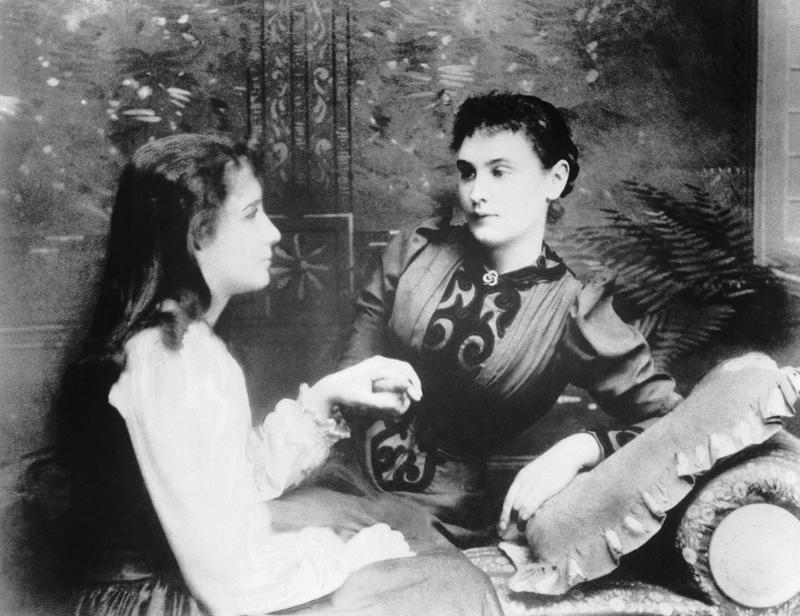
However, after a month of Sullivan’s constant and patient efforts, there was a breakthrough. As Sullivan spelled the word water in one hand while running cool water over the other, Helen Keller made the connection that the gestures symbolized “water.”
Sullivan’s breakthrough in communicating with Keller came the next month when Helen realized that the motions her teacher was making on the palm of her hand while running cool water over her other hand symbolized the idea of “water.” Keller later recalled, “I stood still, my whole attention fixed upon the motions of her fingers. Suddenly I felt a misty consciousness as of something forgotten — a thrill of returning thought; and somehow the mystery of language was revealed to me. I knew then that w-a-t-e-r meant the wonderful cool something that was flowing over my hand. The living word awakened my soul, gave it light, hope, set it free!.” Having released the genie of language out of the bottle, Keller nearly exhausted Sullivan with her zeal to learn the names of the other objects in her world. Within six months under Anne Sullivan’s guidance, Keller learned 575 words and the “multiplication tables as high as five and the Braille system.”
Anne Sullivan would be Helen Keller’s companion for the rest of Anne’s life. She would travel with Hellen to study at the Perkins School for the Blind and later the Horace Mann School for the Deaf. She accompanied Helen to Radcliff, where Keller graduated as a member of Phi Beta Kappa, becoming the first deaf-blind person to earn a Bachelor of Arts degree.
Anne Sullivan would remain a constant companion to Helen Keller until her death on October 20, 1936, with Helen holding her hand. Sullivan was interred at the National Cathedral in Washington, D.C, the first woman to be recognized for her achievements in this way. When Keller died in 1968, she was cremated, and her ashes were interred alongside those of Sullivan.
It was no less a person than Mark Twain who described Anne Sullivan as ‘a Miracle Worker.’ Sullivan not only conquered the darkness of her own early life but opened the world to a young girl cut off and alone. Anne Sullivan’s resolute spirit should inspire all of us.
Neil F. Cosgrove ©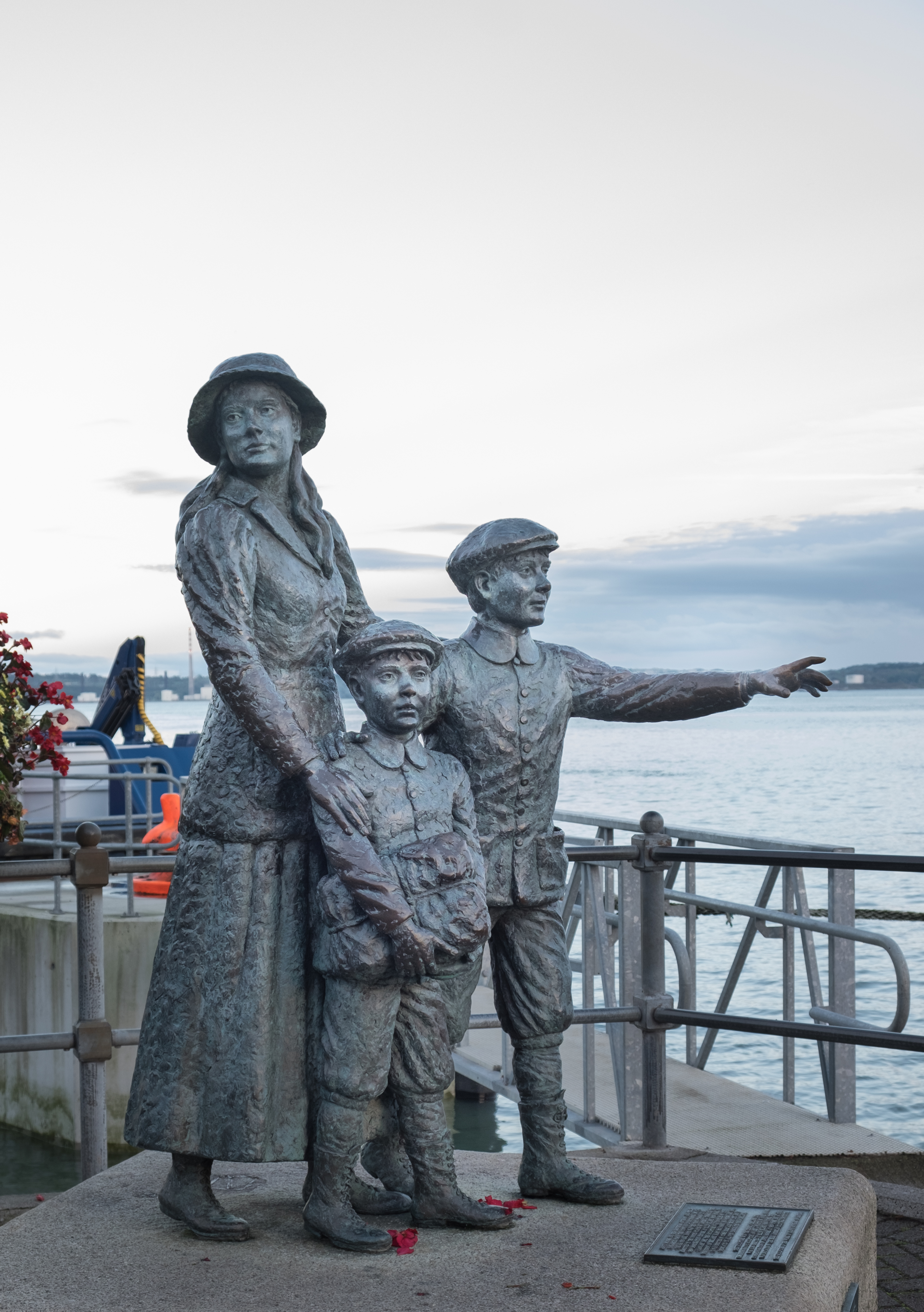
During its period of operation from 1892 till 1954, over 12 million immigrants entered through the immigration station at Ellis Island, a name that was to become synonymous with the “Golden Door” and the “American Dream”. It is estimated that today over forty percent of the United States population can trace their ancestry to an immigrant that entered Ellis Island.
On New Year’s Day Morning 1892 on the deck of the steamship Nevada stood three adolescents, Annie Moore and her brothers Phillip and Anthony. They were perhaps staring at another recent immigrant from France, the Statue of Liberty. The children had made the twelve-day voyage from Cork in the claustrophobic conditions of steerage to be reunited with their parents and older siblings who had traveled on ahead to make a new life in America two years earlier. In addition to the natural apprehension of starting a new life in a strange land, the children had no doubt heard that they would be subject to a series of examinations at the immigration station; they would be checked to ensure they were healthy and then interrogated to ensure they were neither a threat or likely to become “a public charge”. A slight malady or a wrong answer could result in them being returned to the Nevada and a trip back to Ireland alone. It therefore must have been with some anxiety that Annie realized that she would be the first to go down the gangplank.
It must have been quite a shock when Annie now found herself caught up in what we would now call a PR event surrounding the opening of the new immigration station. The New York Times was there and described Annie as “a little rosy-cheeked Irish girl… fifteen years of age.” (Actually, Annie was closer to seventeen years of age. The children’s ages were all misstated on the manifest, perhaps an attempt by their parents to save money on their passage.) Instead of an anonymous immigration agent, Annie was officially registered by the former private secretary to the secretary of the treasury. The Times continued “When the little voyager had been registered Col. Weber presented her with a ten-dollar gold piece and made a short address of congratulation and welcome. It was the first United States coin she had ever seen and the largest sum of money she ever possessed. She says she will never part with it.” This moment was later commemorated in the song “Isle of Hope, Isle of Tears” popularized by the Irish tenor Ronan Tynan.
Sadly, there would be no fairy tale ending to the life of Annie Moore, her brief moment of notoriety would be a shining moment in a hard and trying life. The statement that Annie would never part with the ten dollar gold piece was likely an invention of a romantic reporter; the coin probably never lasted the day when Annie was reunited with her family who was eking out an existence on her father’s longshoreman salary. She would spend the rest of her life living in a series of tenements near the Fulton Street Fish Market. She would marry the son of a German immigrant who was employed as a bakery clerk. They would have 11 children, but would bury five of them. Annie herself would die at the early age of 47 in 1924; burned out by a life of poverty and struggle.
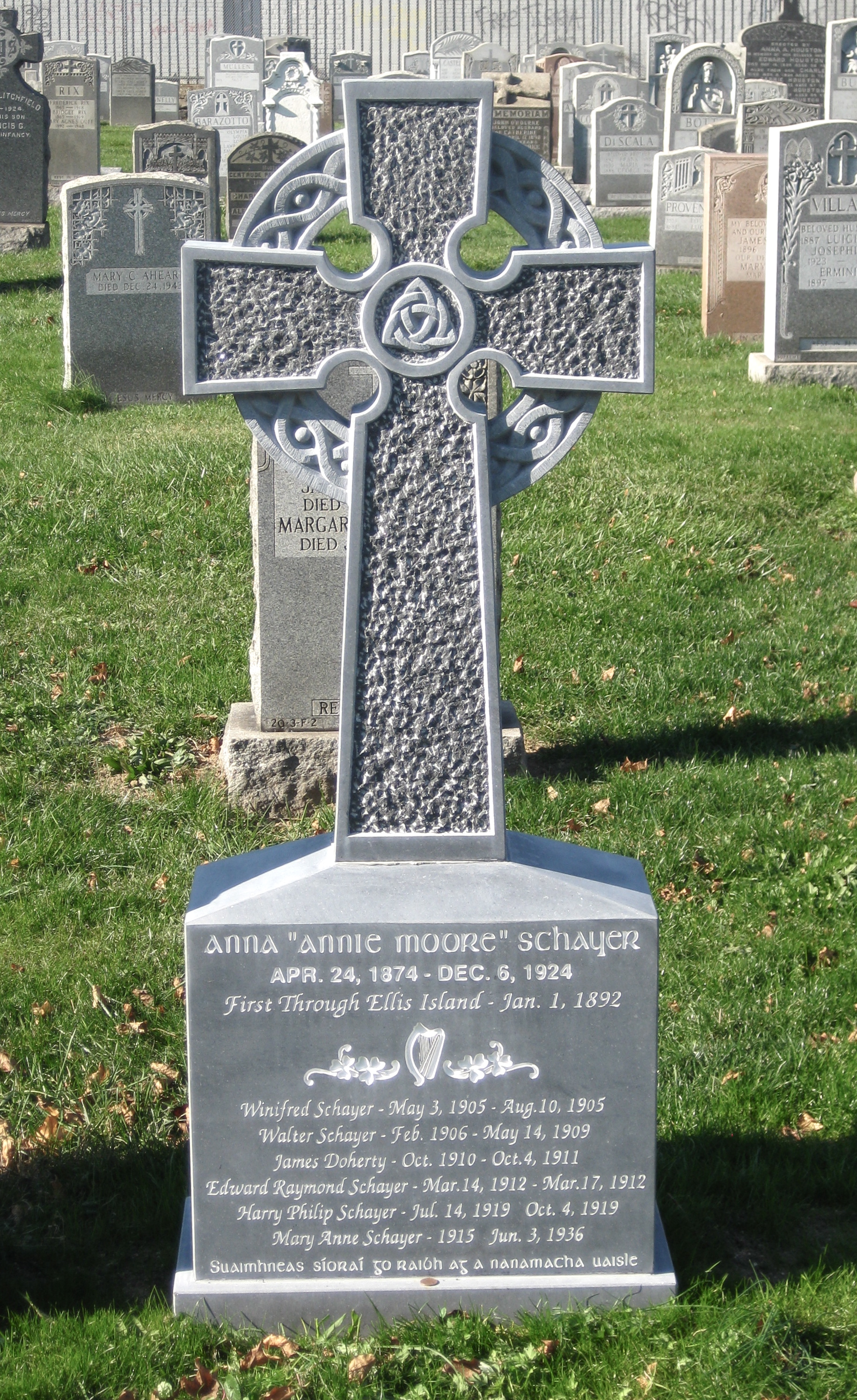
Annie Moore was initially buried in an unmarked grave in Calvary Cemetery, Queens until it was rediscovered in 2006. Through the efforts of the Irish American community, the grave was marked by a Celtic Cross of Irish Blue Limestone. Some cynics questioned the elaborateness of the memorial given the grim reality of Annie’s life. However, in honoring Annie Moore we honor all the other anonymous Irish men and women who came to this country and sacrificed their present for future generations’ tomorrow while at the same time building America. It is reported that many of the current descendants of Annie’s surviving children are successful and respected members of the community.
It is right and proper that we remember the many great Irish American men and women who gained well deserved distinction in government, the military, the arts and sciences. However in remembering Annie Moore we remember the countless other anonymous Irish Americans who loaded our ships as Annie’s father did, built our railroads, fought our fires, patrolled our streets and taught in our schools.
Annie Moore is a reminder that the success of Irish America comes from sweat, sacrifice, and tears and not “the luck of the Irish”. It is time we reclaimed the struggle and successes of Irish America from the unmarked grave where it currently lies buried in our school’s curricula. She is also a reminder that the “Golden Door” that she once walked through is now unjustly closed to Irish immigrants as it freely swings open to others; a challenge to complete her memorial by seeking a fair and just immigration policy for today’s Annie Moore’s.
THIS IRISH AMERICAN HERITAGE MONTH PROFILE IS PRESENTED BY THE ANCIENT ORDER OF HIBERNIANS (AOH.COM)
#IrishAmericanHeritageMonth
Neil F. Cosgrove ©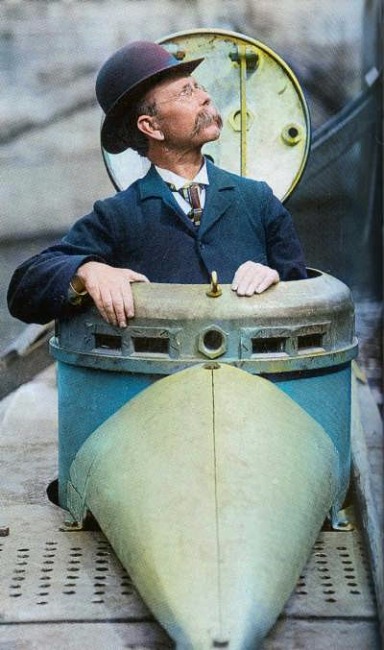
John Phillip Holland was born on February 24, 1841 in small coastal town of Liscannor, County Clare. His mother was a native Irish speaker and young John himself would not learn English until he attended school. Holland’s father was a coastal patrolman for the British Coastguard Service and instilled in the young Holland a love of the sea. With aspirations to go to sea, young Holland walked 5-1/2 miles each way to attend the Christian Brothers secondary school in Ennistymon because they offered a course in navigation. However Holland’s dreams of maritime life were soon dashed by frail health which would plague him throughout his life and poor eyesight.
The family moved to Limerick, where Holland became a student of Brother Bernard O’Brien, a distinguished science teacher and excellent engineer who was a tremendous influence on him. With his father’s death, young Holland began a career as a teacher, and then decided to take his initial vows as a Christian Brother himself. It soon became apparent that young Brother Holland was an inveterate inventor, at one point building a mechanical duck that fascinated his students.
Holland’s health soon intervened in his aspirations to be a Christian Brother. Falling ill, Holland was sent to an Aunt for treatment and to recuperate. While recovering, Holland was taken by accounts of the ongoing Civil War in America and was particularly fascinated by reports of a revolution in Naval warfare: the battle between the ironclads USS Monitor and the CSS Virginia (Merrimack). Holland realized that the age of wooden ships was gone forever and that ironclads were the future. As a child who had experienced the dark side of British rule during the Great Hunger, Holland was concerned that England’s industrial might positioned her to dominate the new technology. Holland wondered “how [other peoples of the world] would protect themselves against those designs.” The course of Holland’s life was set.
Holland returned briefly to the Christian Brothers, but before he could make his final vows illness struck him again causing him to withdraw from the order. Holland decided to follow his mother and brothers who had immigrated to America. Arriving in 1873, Holland took a lay teaching position at St. Joseph’s school Paterson and brought with him plans to counter England’s naval ambitions: a submarine.
Holland initially approached the U.S. Navy to sponsor development of his submarine, but his design was dismissed as impractical. However, Holland’s brother Michael soon found a sponsor for Holland’s work: Clan na Gael, the American branch of the Irish Republican Brotherhood, or Fenians who saw in it a weapon to fight for Ireland’s freedom. After a successful demonstration, the Fenians funded development of a full size submarine that would later be dubbed the ”Fenian Ram”. Holland’s submarine had many of the features that became fundamental to submarine design: it was driven by a combustion engine on the surface, but used battery power when submerged, it was fitted with both ballast and compressed air tanks. In an initial trial, the submarine made 3-1/2 knots on the surface and was able to stay submerged for over an hour and successfully return to the surface.

However, there was one challenge that Holland had not counted on: the classic “Irish split”. Internal fighting within the Fenians and allegations of inappropriate use of the “skirmish fund” resulted in cancellation of funding for Holland’s submarine development. A faction of the Fenians stole the “Fenian Ram” and another prototype. The prototype sank in transit while subsequent attempts by inexperienced crews to operate the “Fenian Ram” resulted in it being impounded as a menace to navigation.
Submarines however were finally gaining the attention of the U.S. Navy. Holland competed for and won a contract to develop a submarine to be named the USS Plunger for the Navy. However, Holland soon realized that the Navy’s shifting design requirements were dooming the project to failure. On his own Holland began developing his own design, the Holland VI. When sea trials came, the USS Plunger proved to be the disaster that Holland had predicted. Holland then demonstrated the Holland VI which in trials exceeded the Navy’s requirements. The Holland VI was commissioned into the U.S. Navy on April 11, 1900 as the USS Holland, the U.S. Navy’s first modern submarine and an order for an additional six more was placed.

It would be nice if the story could conclude on this triumph as a happy ending, but it cannot. Holland’s vision always exceeded his meager pocketbook and he was near poverty. To continue his work Holland formed a partnership with Isaac L. Rice, a businessman who controlled the manufacture of the storage batteries that were integral to Holland’s design. Holland and Rice formed a new company, fittingly called Electric Boat, which is still in operation today as the leader in submarine design. Holland soon found that his partner began isolating him, forcing him into less and less significant roles within his own company while others took credit for Holland’s ideas as they now rapidly evolved with proper financial backing. Holland left Electric Boat to form his own company, only to be dragged through the courts by Electric Boat who claimed not only ownership of Holland’s patents but even Holland’s own name as applied to submarines. While Holland eventually won in court, the damage had been done, potential investors had been scared off. Holland, broken and bitter, was forced into retirement. John Phillip Holland died at his home in Patterson on August 12, 1914 just as World War I was breaking out in Europe, a war in which Holland’s vision of the submarine would be proven with devastating effectiveness.
The genius of Irish Immigrant John Phillip Holland deserves a kinder fate. Holland’s discoveries and his over twenty patents are still protecting our national security today in the shield that is the Navy’s submarine fleet.
Neil F. Cosgrove ©
At the young age of 32, Thomas Foley was already an 11-year decorated veteran firefighter of the FDNY and a legend. He was a larger than life individual who embraced life to the fullest and seemed to excel at everything he tried from powerlifting to skydiving. Having learned to ride horses on visits to his grandfather’s farm, he even excelled as a competitor on the rodeo circuit. With boyish good looks, Thomas Foley was featured twice by People Magazine and appeared in the FDNY’s “2003 Calendar of Heroes.”
However, being a firefighter was Thomas Foley’s first passion; it was all he wanted to do since visiting the firehouse of a family friend as a boy “running around and getting filthy dirty.” Years later, young Tommy Foley’s dream was fulfilled; a fellow firefighter remembered Thomas Foley as “Coming out of a fire, filthy, coughing, covered in black soot and when he’d see you he’d have that big smile on his face.” On August 30, 1999, Thomas Foley gained national notoriety when he rappelled down a seventeen-story building to perform a daring rescue when a collapsed scaffold left two workmen hanging on for their lives. He was truly one of the Bravest of the Bravest.
Responding to the attack on 9/11 as a member of the elite Bronx Rescue Company 3, Thomas Foley rushed to the World Trade Center; he and his entire Company would be among the 343 FDNY firefighters killed on that day when the towers collapsed.
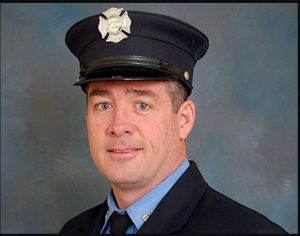
Dan Foley, Thomas Foley’s younger brother, had followed in his brother’s footsteps to join the FDNY. He was off duty on 9/11, but rushed to the site when it was reported that his brother Tommy was missing. When it became apparent that Tommy was gone, Dan Foley promised his parents he would not leave the site until he found his brother. Amazingly amidst the tons of rubble and debris, Dan Foley found his brother ten days later and carried the body of his body from ground zero; Dan kept his word, he brought his brother home.
What Dan Foley and hundreds of other first responders engage in the recovery efforts at ground zero did not realize was that they too would become casualties of 9/11. After a distinguished 21-year career with the FDNY as a member of his fallen brothers Rescue Company 3, Dan Foley passed away from 9/11 related cancer on February 22, 2020, leaving behind a wife and five children. He was forty-six. It is not surprising that days before the diagnosis of his illness, on what would be his last day as a firefighter, Dan Foley was credited with saving four young children from a burning apartment.
At one awards ceremony where Thomas Foley was being honored, he responded to a question regarding the source of his drive and accomplishments by smiling and saying, “When anyone asks me, I just tell them ‘I’m Irish.’” Our heritage seems to generate remarkable men and women with astonishing regularity. The story of the Foley Brothers is a story that our Irish heritage has so often produced; the story of the Foleys now joins the story of the Sullivan and Niland brothers. Because of Irish Americans like Thomas and Dan Foley, we too should never hesitate to say “I’m Irish” and never let being Irish be trivialized.
THIS IRISH AMERICAN HERITAGE MONTH PROFILE IS PRESENTED BY THE ANCIENT ORDER OF HIBERNIANS (AOH.COM)
#IrishAmericanHeritageMonth
Neil F. Cosgrove ©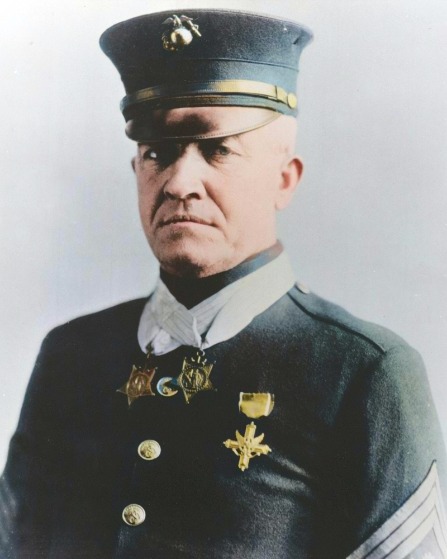
In the history of the Medal of Honor, the United States Highest award for “conspicuous gallantry and intrepidity at the risk of his life above and beyond the call of duty“, only 19 men have been awarded the medal twice. Among them is Marine Sergeant Major Daniel Daly, one of only two marines to receive the Medal of Honor Twice for separate acts of heroism and nominated for a third.
Daly was born in Glen Cove, Long Island, New York, on 11 November 1873. He was slight of stature, only 5’ 6″ in height and weighing 132 lbs, yet enjoyed an early reputation as a fighter, a reputation he would prove more than deserved.
Daly was part of the U.S. Embassy Guard in Peking when the Boxer Rebellion broke out in 1900. In one of the most memorable acts of that war, the Boxers surrounded the compound of the foreign legations in Peking and laid siege to it for 55 days. At one point, when German Marines of the German embassy were forced back, Daly by himself took a position in a bastion on the Tarter Wall and remained there throughout the night. Subjected to sniper fire and numerous attacks, when relieved in the morning Private Daly was still holding his position with the bodies of numerous attackers surrounding his position attesting to his bravery. For this he was awarded his first Medal of Honor.
“Had one squad failed, not one man of the party would have lived to tell the tale. Gunnery Sergeant Daly, 15th Company, during the operations was the most conspicuous figure among the enlisted men.”
Fifteen years later found now Gunnery Sergeant Daly in Haiti fighting against the Cacos. The reconnaissance company of 38 men that Daly belonged to was ambushed by over 400 of the enemy while attempting to ford a river at night. Among the casualties was the mule carrying the company’s machine gun. After getting his men to a good position, Daly returned, alone and under enemy fire, to the river and searched for the gun. He found it, and was able to bring the gun and its ammunition back to the Marine position. Daly then took command of one part of a three pronged assault on the rebel position, killing 75 rebels and scattering the rest. As one of the two officers present noted, “Had one squad failed, not one man of the party would have lived to tell the tale. Gunnery Sergeant Daly, 15th Company, during the operations was the most conspicuous figure among the enlisted men.” Daly was awarded his second Medal of Honor.
However, Daly was not finished yet; there was yet the incident for which he is perhaps best remembered in the Marines. In June 1918, at the battle of Belleau Wood in World War I, the Marines were under a heavy artillery barrage and pinned down. Realizing that to stay where they were would lead to certain death, the now 44 year old Daly, led a counter-attack with a battle cry that has become Marines lore, “Come on, you sons of B——, do you want to live forever?!” Later in the battle, Daly single-handedly eliminated a machine gun nest with nothing more than his 45 pistol and grenades. In the course of the battle he was wounded three times.
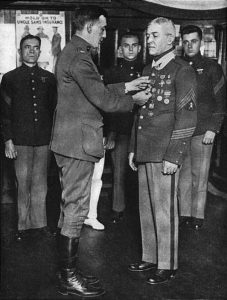
Daly was recommended for a third Medal of Honor, and the NY Times reported it as a certainty. However, petty bureaucratic politics came into play, and a capricious decision was made that the Medal of Honor could only be awarded twice, no matter how deserving subsequent acts of valor were. Daly’s third Medal of Honor was denied solely on this technicality; instead, he was awarded the Distinguished Service Cross, the Navy Cross, and France’s Médaille Militaire.
Perhaps the greatest tribute was paid by General Smedley D. Butler, the other Marine to be awarded two Congressional Medals of Honor for separate acts of valor, who called Daly “The fightinest Marine I ever knew.” Offered promotion several times, Daly once remarked “I would rather be an outstanding sergeant than just another officer“.
Neil F. Cosgrove ©